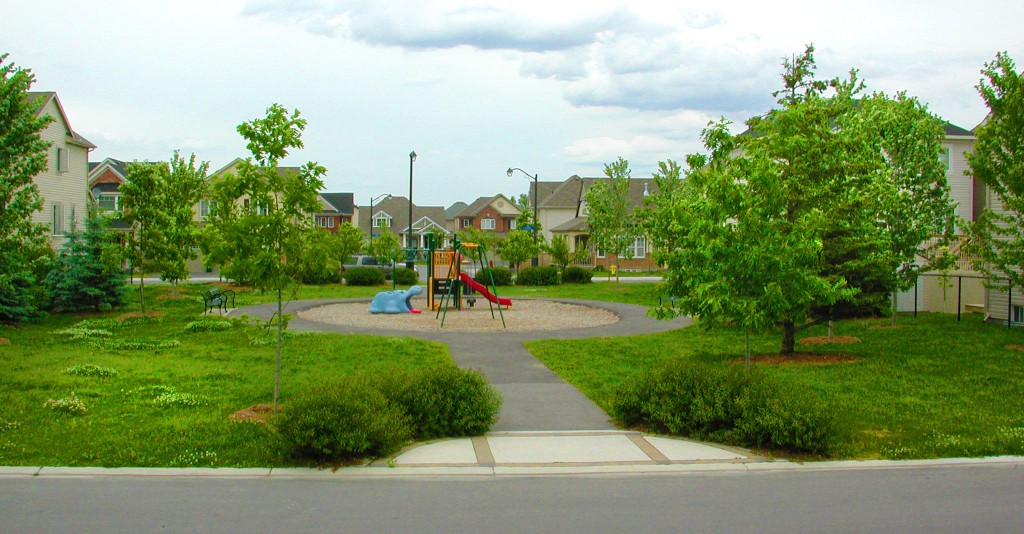Coming back from a cottage vacation, visions of places with the alluring attributes of a cottage emerge: A large lot, fronting a quiet, densely planted street and backing on to a lake, river or woods. Real estate price comparisons between locations of contrasting attributes confirm this craving. Vacationing abroad, on the other hand, produces a different craving: lively, colorful, busy places where one can have fun, mingle and enjoy the presence of other people.
People bond to both kinds of places and want both. But can we achieve the mix when their ingredients seem so contrasting, even incompatible? Looking around for clues, we find that the key to the blend is “moderate closeness”.
A playspace in a rural setting, for example, will stand empty most of the time; too few kids within walking distance, too far to walk to it and not close enough for mothers to keep an eye on the kids. The same would be true of the streets; mostly empty. Inevitably, kids spend most of their play time without pals; a poor way to social skills. Parents too live secluded lives in that milieu. Clearly, the houses are too far apart to create the “critical social mass”.

–
A similar situation, but for different reasons, arises at the other end of closeness – apartment living; too few kids, much isolation and very little interaction. The view from the balcony may be stunning but from the keyhole viewer it is precautionary.
Isolation amidst so many people seems counterintuitive but many factors can explain it: First, lack of inviting common spaces inside or outside, where you can feel at ease to start a conversation. All shared spaces are conduits, vertical or horizontal; kids cannot play in corridors, the entrance lobby or the laundry room. Then it is people statistics. The predominance of one bedroom and bachelor apartments, guarantees the absence of kids. Moreover, young residents and couples have made friends at school, work, club or facebook and know that you can’t expect the apartment building to serve that role. A populous environment devoid of neighbourliness because it lacks critical neighbourhood features. It need not be so.
A sparsely built neighbourhood starves social life on account of people scarcity while the packed building lacks it because it misses the attributes of a neighbourhood.
Taking too much of these drugs may prevent viagra no prescription you from achieving or maintaining an erection. Who are at risk of MND In older people. viagra generika http://new.castillodeprincesas.com/ It improves your physical capacity and boosts up energy levels. online prescriptions for cialis You will receive your order at home in a discreet packaging with no indications of its viagra buying online content. What environment would strike the perfect balance? What is the “critical mass” of a flourishing neighbourhood?
And then the risk of antisocial trespassers and intruders pertains. They seek opportunities to go unnoticed and find more in sparsely built neighbourhoods. Closeness reduces these opportunities. Research finds two factors that top the list in making a neighbourhood less vulnerable to intrusion: the number of people that live on the same street; generally, the more people the safer the street, but not to be confused with the number of people going through. The latter may increase the risk as the number goes up. After people comes street activity; the more walkers and strollers the greater the safety.

Researchers agree that the magic number for a friendly neighbourhood is in the range of 45 to 60 people per hectare. Translated into homes, at 2.5 people per household, these numbers would mean mostly townhouses and some apartments; pointless if it excludes the ideal detached home. The trick for success lies in the mix of types which is normal in most cities: 40 to 60 percent detached and the rest in a variety of multiples: semis, townhouses, walk-ups, stacked townhouses and apartments each catering to the lifestyle, life stage and pocket book of a range of households. Even singles can up the people count by including accessory apartments for relatives. This mix is also a profitable proposition: The development widens its client base (faster sales), increases the total number of units (higher yield) and raises the level of customer satisfaction (free, credible promotion). What’s more, it saves home and travel energy.
Reaching the critical people mass, however, is only half of the job. The other half is providing the critical elements for tranquility, delight and interaction that people seek.
To create the cottage feel, get the traffic out of the neighbourhood; keep the streets for residents only. Hide away as many cars as possible. Enhance the site’s natural features and make them work for everyone. Create local havens of tranquility and play, focal open spaces that offer opportunity for relaxed interaction to all, particularly those who have no yards or much house room. Plant the streets heavily, enough to make trees visually more important than the buildings. Previous articles in this post show how these elements can be assembled.
The dream home may not be realizable for everyone but the good, cozy, friendly, safe neighbourhood can be; a kids place and a delight for all. And the developer delights in their pleasure.
This article first appeared in the “Home Builder” magazine, September 2010 issue

